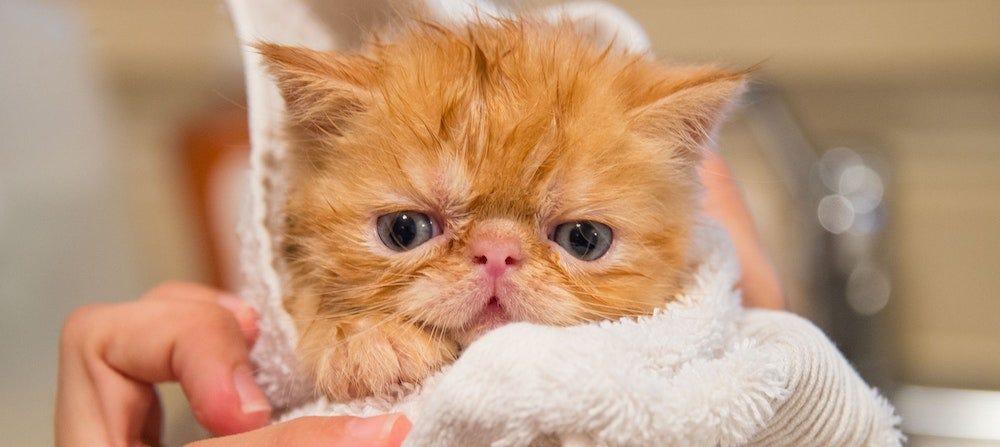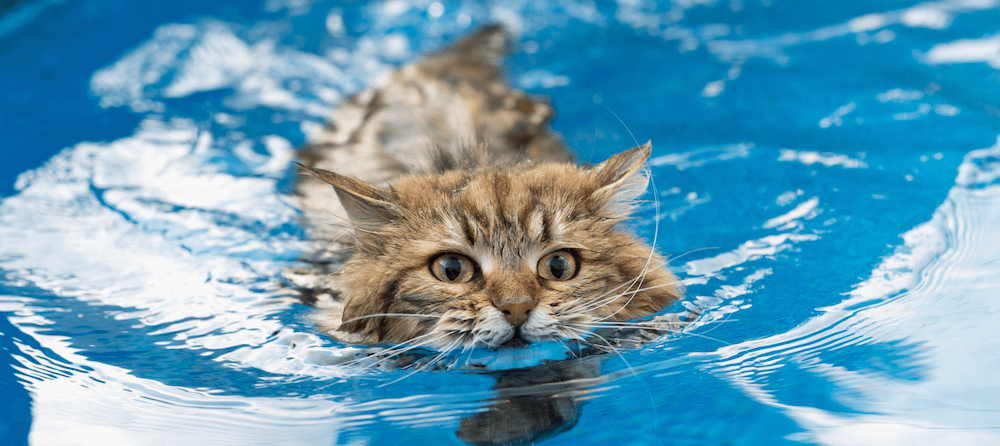Giving a cat a bath can be a truly intimidating situation. Most cats abhor being immersed in water. Even if you have a unique cat that likes water, bathing a feline is an exercise in patience and, sometimes, pain tolerance. Let’s explore how to give a cat a bath, pain-free—with or without water.
First, do cats need baths?

You may wish to spare your cat needless trauma and yourself needless pain by skipping a cat bath—and most of the time, you can! Cats are generally fastidious about grooming themselves, which means they rarely require washing on your end. Instead, regularly brushing your cat may be the best way to help them maintain a healthy coat.
So when do cats need baths? Usually a cat bath is necessary only if they’ve soiled themselves, or if they’ve gotten into a messy situation in the house (such as dust, cobwebs, or chimney ash) or outside (such as mud, feces, or a skunk attack). Certain fungal diseases like ringworm or infestations like fleas may require giving a cat a bath, as well.
Hairless cat breeds such as the Sphynx require weekly sponge baths to remove sebaceous oils from their skin. Cats with fur usually absorb these oils; hairless cats that are not wiped down may feel sticky to the touch and develop skin problems
How to give a cat a bath – without water!
We’ve explored why most cats hate water, the reasons being a combination of their descending from the desert and moisture-absorbent fur coats. Enter a waterless solution: bath foam washes.
Similar to using dry shampoo, this kind of foam wash doesn’t require water in order to clean your cat’s fur. This kind of wash uses safe ingredients like glycerin to retain moisture and leave a nice shine on your cat’s coat. It also detangles hair, moisturizes skin and coat, reduces itchy skin, and reduces skin flaking. Just be sure to avoid direct contact with eyes and ears.
How to give a cat a bath – with water
First, put up a sign on your bathroom door: “Abandon all hope, ye who enter here…” Just kidding! There are a few tricks to giving a cat a bath the regular way.
Preparation and grooming before the bath
1. Gather supplies:
- Rubber gloves: Protect yourself from scratches.
- Cotton balls: Prevent water from entering your cat’s ears.
- Large towel and soft cloth: For drying.
- Gentle spray nozzle or plastic pitcher: For rinsing.
2. Choose the right shampoo:
Use only a vet-recommended shampoo specifically formulated for cats.
- Avoid human or dog shampoos: These may contain ingredients toxic to cats (e.g., permethrin, certain essential oils) or have a pH that’s too acidic for their skin.
- Can you use Dawn dish soap? In emergencies, Dawn dish soap can be used to bathe adult cats, but it may irritate their skin with frequent use. It’s most commonly recommended for kittens with fleas who are too small for flea medication.
3. Groom and prep:
- Trim claws: Reduce the risk of scratching.
- Brush fur: Remove loose hair and mats to make bathing easier.
- Place cotton balls in your cat’s ears to keep water out.
The bathing process
1. Use lukewarm water:
- Fill a tub or basin with 3–4 inches of lukewarm water (never hot water).
- Use a rubber bathmat to provide stability for your cat and prevent slipping.
2. Begin bathing:
- Wet the coat: Starting from the shoulders to the tail, use a gentle spray nozzle or plastic pitcher to wet your cat’s fur thoroughly, avoiding the face.
- Apply shampoo: Dilute cat shampoo (1 part shampoo, 5 parts water) and lather gently, working from neck to tail with the grain of the fur. Avoid sensitive areas like the eyes, ears, and nose.
- Rinse thoroughly: Use lukewarm water to remove all shampoo. Residual soap can irritate the skin or attract dirt and may harm your cat if ingested during grooming.
3. Cleaning the face:
- Use a damp cloth to wipe the face, ears, eyes, and nose. Plain water is usually enough, but for stubborn dirt, a highly diluted shampoo solution can be used with care.
Drying your cat
1. Wrap and dry:
- Wrap your cat in a warm towel and gently rub their fur dry. Choose a warm, draft-free area for drying.
- For long-haired cats, use a wide-toothed comb to detangle their fur during the drying process.
2. Blow-drying (optional):
- If your cat tolerates noise, use a blow dryer on low heat to speed up the drying process. Monitor closely to ensure your cat remains comfortable.
Post-bath care and alternatives
Don't forget to reward your cat! Treats after the bath can create positive associations and make future baths easier.
There’s no universal secret to bathing a cat, but with patience, preparation, and the right techniques, you can help your feline friend stay clean and comfortable. By following these tips and using the proper products, you can ensure bath time is as stress-free as possible for both you and your cat.




